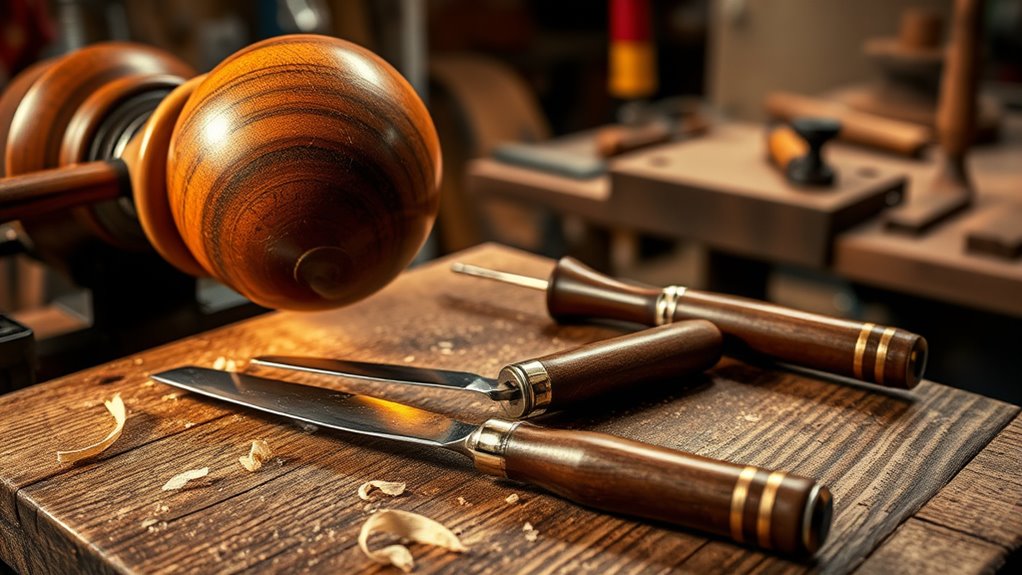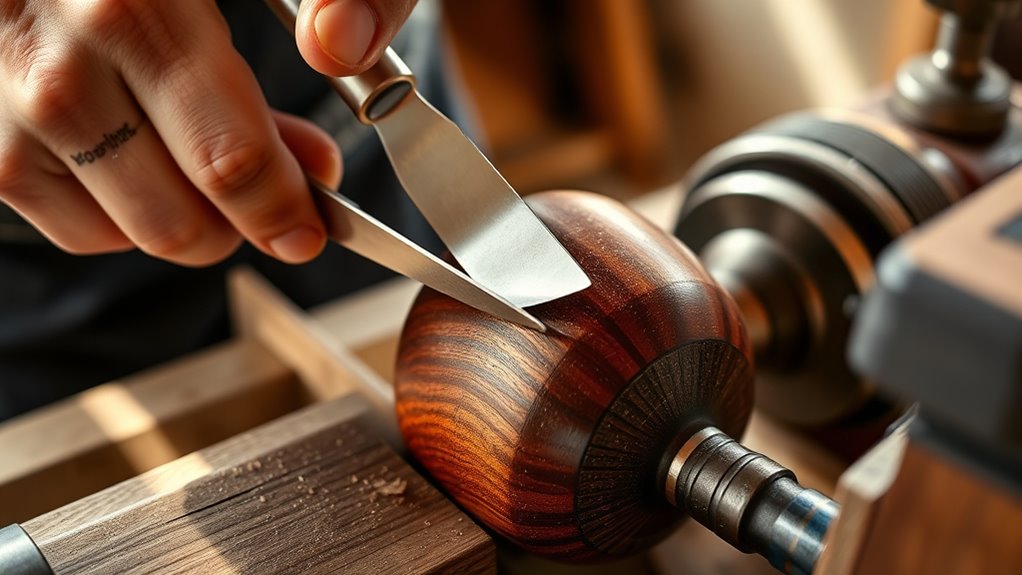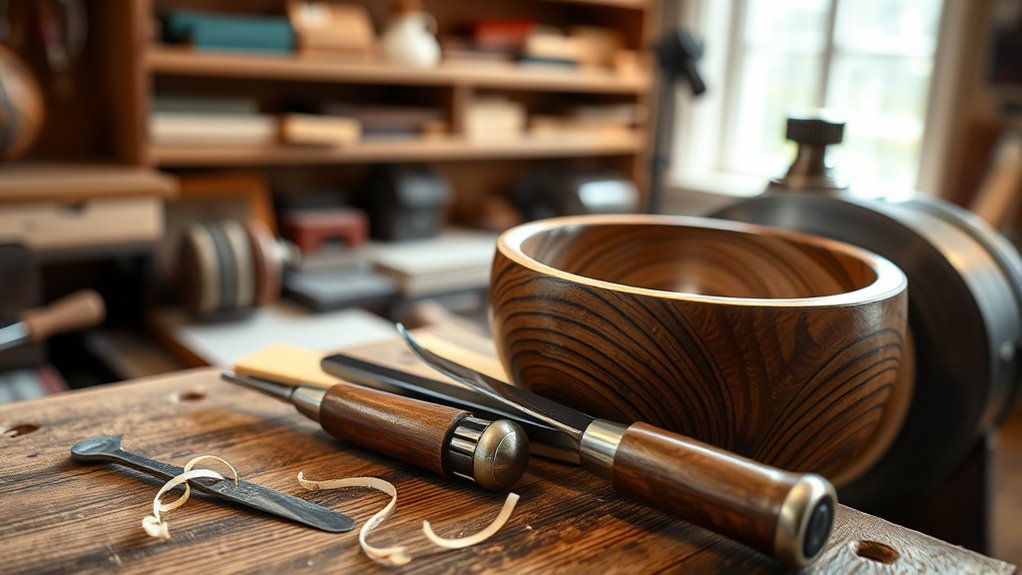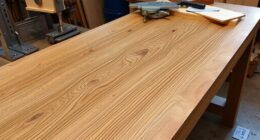To master wood turning, focus on essential tools like the roughing gouge, spindle gouge, bowl gouge, and skew chisel for various cuts and shapes. Set up your workspace with safety in mind, ensuring proper lighting and organization. Practice controlling your tools with steady pressure, proper grip, and smooth movements. Regularly sharpen your tools to maintain sharpness and safety. Keep exploring different projects and techniques to refine your skills—more tips are waiting for you as you continue.
Key Takeaways
- Familiarize yourself with core tools like roughing, spindle, and bowl gouges, and their specific uses in wood turning.
- Maintain a safe workspace with proper lighting, organization, and safety equipment to ensure safe and efficient turning.
- Practice controlling tool angles and bevels, using steady pressure and body movement for smooth, precise cuts.
- Regularly sharpen tools using appropriate systems to improve cut quality, safety, and tool longevity.
- Follow proper finishing techniques, including sanding and applying suitable finishes, for professional-quality results.
Understanding the Core Tools for Wood Turning

To effectively work on your wood turning projects, it is vital to understand the core tools you’ll use. The essential turning tools include the roughing gouge, spindle gouge, bowl gouge, skew chisel, and other shaping tools. The roughing gouge helps you quickly convert square stock into a round shape, usually with the flute facing up. The spindle gouge is versatile for detailed spindle work, shaping coves and beads. The bowl gouge is designed specifically for bowls, offering smooth, clean cuts with its deep flute and fingernail grind profile. The skew chisel, with its flat blade and beveled edges, provides smooth cuts for beads and V-grooves. Always use a tool rest to support your tools and sharpen them regularly to maintain precision and safety in your wood turning. Proper tool maintenance enhances cutting accuracy and prolongs tool life. Additionally, maintaining your tools involves understanding sharpening techniques, which are crucial for optimal performance and safety. Developing a consistent sharpening routine helps ensure your tools stay in top condition for each project. Moreover, familiarizing yourself with proper safety practices is essential to prevent accidents and ensure a safe working environment. Incorporating techniques like sound therapy into your routine can also improve focus and reduce stress during detailed work.
Setting Up Your Workspace Safely and Effectively

Setting up your workspace properly creates a safe and efficient environment for wood turning. Start by guaranteeing ample space around the lathe to prevent accidents and allow free movement. Use a sturdy, level work surface with proper lighting so you can clearly see your tools and workpiece. Organize your tools and accessories on a designated shelf or tool rack within easy reach to streamline your workflow. Maintain debris management by regularly clearing shavings, dust, and debris to reduce fire hazards and keep your workspace clean. Set up safety equipment like a dust extractor, fire extinguisher, and first aid kit nearby. Always check that safety guards are in place before turning to protect yourself and ensure workspace safety. Additionally, exploring celebrity transformations can provide inspiration for embracing change and developing new skills in your woodworking journey.
Techniques for Handling and Controlling Your Tools

Mastering proper handling and control of your wood turning tool is essential for achieving clean, precise cuts and ensuring safety. Keep the tool rest close to the wood to maximize stability and reduce vibrations, which helps you maintain better control. Use your grip and handle angle to match the tool’s designed cutting zone, giving you better precision and less fatigue. Consistently employ bevel control during cuts, introducing the bevel before engaging the cutting edge for smoother, more controlled shaping. Practice steady, controlled motions with light pressure, avoiding forcing the tool into the wood to prevent catches. Incorporate your body movement by shifting your weight and positioning to create fluid curves and maintain stability during intricate cuts. This approach guarantees safety and precision every time you turn. Additionally, understanding the proper juice cleansing techniques can help improve your overall health and ensure your body is well-prepared for physical activities. Developing a keen sense of tool control can significantly enhance your craftsmanship and reduce the risk of accidents. To further refine your skills, consider reviewing the support hours for resources and assistance when needed.
The Importance of Sharpening and Tool Maintenance

Regularly sharpening your wood turning tools is essential for producing clean cuts and ensuring safety. Proper tool maintenance, including honing and grinding, keeps the bevel and edge sharp, which improves control and reduces the risk of catches or tear-out. Using systems like Tormek or diamond pads makes sharpening easier and more effective, maintaining a keen edge with less effort. A well-maintained edge not only enhances cut quality but also extends the tool’s lifespan by preventing unnecessary wear or damage. Routine inspection and timely sharpening are key to achieving smooth, crisp work while promoting safety during turning. Remember, dull tools force you to work harder and pose a safety risk, so consistent sharpening and proper maintenance are crucial for mastering wood turning. Regular use of quality sharpening systems like Glycolic Acid can also improve the effectiveness of your maintenance routine by keeping tools in optimal condition. Additionally, understanding the importance of tool longevity can motivate you to maintain your tools properly and maximize their lifespan. Furthermore, staying informed about AI security vulnerabilities can help you implement safer practices in your workshop, especially if you incorporate advanced tools or digital systems. Incorporating routine inspection and maintenance can further prevent unexpected tool failures and ensure consistent results.
Exploring Different Types of Turning Projects and Finishing Methods

Different turning projects, such as bowls, spindles, and platters, demand specific tools and techniques to achieve the best results. Your choice of finishing methods depends on the project’s purpose, whether decorative or functional. Proper wood preparation, including correct wood grain orientation and mounting techniques, is essential for a smooth surface and easy sanding. Using appropriate sanding techniques—progressively moving from coarse to fine grit—ensures a high-quality surface. When it comes to coating options, you can choose from oils, waxes, CA glues, or food-safe finishes, depending on the item’s use. Surface finishing enhances both appearance and durability, so selecting the right finishing products and applying them carefully will give your projects a professional look and long-lasting beauty. Additionally, understanding the diverse best beaches can inspire you to incorporate natural beauty into your woodworking projects, such as using shells or driftwood for decorative accents. Exploring different wood types can also influence the final look and feel of your finished piece, adding unique character and strength. Incorporating local materials like reclaimed wood or regional motifs can further personalize your work and connect it to specific environments. Paying attention to grain orientation can significantly improve the ease of carving and the overall quality of the finish. Moreover, practicing proper wood selection techniques can help you choose the right materials from the start, leading to better results and less waste.
Frequently Asked Questions
What Are the ABCS of Woodturning?
When you ask about the ABCs of woodturning, you’re looking at the basics that help you get started. You need to understand key tools like gouges, skews, and faceplates, along with safety practices. Learning fundamental techniques such as spindle and faceplate turning builds your confidence. By mastering proper tool use, sharpening, and control, you’ll create smoother cuts, avoid catches, and set a strong foundation for more advanced projects.
What Are 6 Turning Tools?
Think of your turning toolbox as a painter’s palette, each tool adding a different stroke. You’ll need six key tools: the roughing gouge to reshape square stock into round; the spindle gouge for detailed spindle work; the bowl gouge for shaping bowls; the skew chisel for fine detailing; the parting tool to cut and measure; and the scraper for smoothing and finishing surfaces. Master these, and your projects will truly come alive.
What Is the Best Way to Sharpen Woodturning Tools?
To sharpen your woodturning tools effectively, use a dedicated sharpening system like a Tormek or diamond honing pads for consistent edges. Maintain a bevel angle of 30–40 degrees, regularly inspect and reshape the edge to remove nicks, and avoid overheating with a water-cooled grinder. Always test the sharpness on scrap wood or paper before turning to guarantee a smooth, burr-free edge, making your tools cut effortlessly.
Can You Make Money With a Wood Lathe?
You might wonder if your wood lathe skills can truly pay off. The answer is yes, but success hinges on more than just turning wood. If you start small, focus on unique, high-quality pieces like custom pens or bowls, and sell at local markets or online, you can build a profitable side business. Consistent quality, branding, and marketing will turn your hobby into a sustainable income stream.
Conclusion
Mastering wood turning isn’t just about tools and techniques—it’s about revealing your creative spirit. With patience and practice, you’ll transform raw wood into stunning art, turning every cut into a testament of your skill. Remember, every master was once a beginner, and each chip you carve is a step closer to mastery. Embrace the journey, because in the dance between you and the wood, magic happens—waiting to be shaped by your hands.





